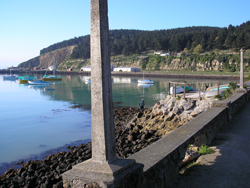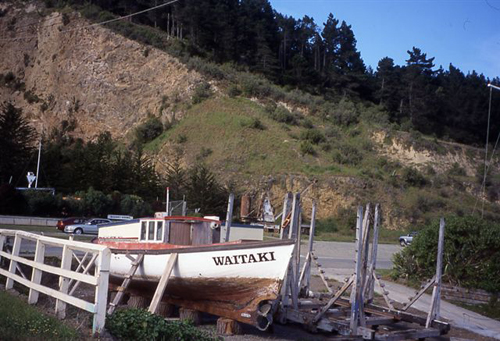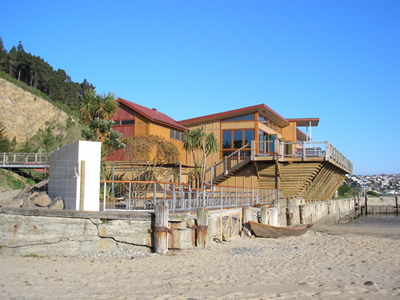

| Oamaru Harbour: a history |
The sailing of the Holm Shipping Company freighter Holmdale in March 1974 was the end of an era, marking the termination of the commercial trading history of Oamaru as a seaport. With conventional coastal shipping being negatively impacted by intermodal competition – subsidised state-owned railways as well as the new unit-load RORO ferries – the Oamaru Harbour Board abandoned the routine dredging programme until it could ascertain the outcome of this broader transport revolution. The Board treated itself to a centennial dinner and other activities in 1974, but submitted to the realities of the situation and in 1978 was abolished, and its responsibilities were transferred to the territorial local authority, the Oamaru Borough Council.


Since 1974 traffic at the harbour has been restricted to vessels of under 100 grt, mainly inshore fishing vessels, a small but growing fleet of pleasure craft, and occasional show-the-flag visits by one of the RNZVR’s IPCs (inshore patrol craft). Since most of these craft contribute little more than mooring fees, the local authority has been severely challenged to maintain facilities designed for revenue-producing vessels. There has been a pronounced, albeit gradual, deterioration of harbour infrastructural elements, and an increasing resort to either the imposition of restrictions on public access or the partial demolition of unsafe structures.
The creation of a new tourism industry in the town has brought both new opportunities and new threats to the harbour infrastructure. The principal drivers have been the establishment by the Department of Conservation and the Waitaki District Council in 1992 of a blue penguin (Eudyptula minor) colony in the former OHB quarry by the breakwater, and the subsequent connection of the colony area to the historic Harbour/Tyne Street precinct by a volunteer-operated railway. In 2006 a new tourist-oriented upmarket restaurant opened on the 1879 Cross Wharf.
These developments have regenerated economic activity in the southern sector of the former port area, but will have to be managed more carefully to preserve the historic ambience of the port area. In 2005 the Department of Conservation included Historic Oamaru/Seaport on a tentative indicative list for World Heritage listing by ICOMOS (the International Council of Monuments and Sites). Heritage advocates warn that it will be essential for stakeholders to produce systematic and comprehensive management plans to ensure the preservation of the optimum amount of heritage fabric while permitting a programme of ongoing adaptive reuse.
|
 |
|
Table of Contents
|
Early Days |
Colinial Beach Head |
Deep Water Port |